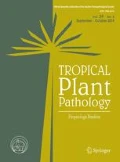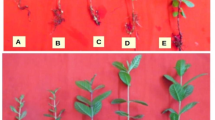Abstract
Rotation with nonhost crops is an important practice used for root-knot nematode (RKN) management. Screenhouse experiments were conducted to evaluate the response infection of 27 cultivars belonging to 14 crops (blackgram, cabbage, cauliflower, chickpea, cowpea, garlic, ginger, greengram, groundnut, maize, potato, sesame, soybean, sunflower), which are grown in rotation with rice in lowland and upland rice-based ecosystems, to the RKN Meloidogyne graminicola. Root galling indices observed on all crop rotation cultivars were significantly lower compared with the rice cv. Thihtatyin, used as positive control. Differences in host response to M. graminicola infection were observed between cultivars. All 27 cultivars were poor or non-hosts of M. graminicola, except cv. Yezin 4 of chickpea considered as good host. No significant differences in plant growth were observed between non-inoculated and inoculated plants of all plant/species cultivars, with the exception of a reduction in root length in the chickpea cv. Yezin 4 (good host) and the garlic cv. Shan (poor host). Rotation crops identified as poor or non-hosts of M. graminicola could be useful in the management of RKN in rice-based cropping systems.
Similar content being viewed by others
References
Arayarungsarit L (1987) Yield ability of rice varieties in fields infested with root-knot nematode. Int Rice Res Notes 12:14
Bridge J (1996) Nematode management in sustainable and subsistence agriculture. Annu Rev Phytopathol 34:201–225
Bridge J, Page SLJ (1980) Estimation of root-knot nematode infestation levels on roots using a rating chart. Trop Pest Manag 26:296–298
Bridge J, Plowright RA, Peng D (2005) Nematode parasites of rice. In: Luc M, Sikora RA, Bridge J (eds) Plant parasitic nematodes in subtropical and tropical agriculture, 2nd edn. CABI Publishing, Wallingford, pp 87–130
Cabasan MTN, Fernandez L, De Waele D (2016) Host response of Oryza glaberrima and O. sativa rice genotypes to the rice root-knot nematode Meloidogyne graminicola in a hydroponic system under growth chamber. Arch Phytopathol Plant Protect 48:740–750
Davis RF, May OL (2003) Relationships between tolerance and resistance to Meloidogyne incognita in cotton. J Nematol 35:411–416
De Waele D, Elsen A (2007) Challenges in tropical plant nematology. Annu Rev Phytopathol 45:457–485
De Waele D, Das K, Zhao D, Tiwari RKS, Shrivastava DK, Vera-Cruz C, Kumar A (2013) Host response of rice genotypes to the rice root-knot nematode (Meloidogyne graminicola) under aerobic soil conditions. Arch Phytopathol Plant Protect 46:670–681
Duxbury JM (2002) Sustainability of post-green revolution agriculture: the rice wheat cropping system of South Asia. Soil Management-Collaborative Research Support Program, University of Hawaii, Hawaii, p 43
Edward JC, Sharma NN, Agnihothrudu V (1985) Rice root nematode (Hirschmanniella spp.) - a review of the work done in India. Curr Sci 54:179–182
Fernandez L, Cabasan MTN, De Waele D (2013) Life cycle of the rice root-knot nematode Meloidogyne graminicola at different temperatures under non-flooded and flooded conditions. Arch Phytopathol Plant Protect 47:1042–1049
Ferris H, Carlson HL, Viglierchio DR, Westerdahl BB, Wu FW, Anderson CE, Juurma A, Kirby DW (1993) Host status of selected crops to Meloidogyne chitwoodi. J Nematol 25:849–857
Gergon EB (2002) Occurrence, disease cycle, effects on yield, and management of root knot disease of onion (Allium cepa L.) caused by Meloidogyne graminicola Golden and Birchfield. PhD Thesis, University of the Philippines Los Banos, Laguna, Philippines
Gergon EB, Matias DM, Prot JC (1998) Host status of different potential rotation crops, weeds and onion varieties in rice-onion cropping system to Meloidogyne graminicola Golden and Birchfield. Phil J Crop Sci 23:37
Greco N, Di Vito M (2009) Population dynamics and damage levels. In: Perry RN, Moens M, Starr JL (eds) Root-knot nematodes. CABI Publishing, Wallingford, pp 246–274
Jain RK, Khan MR, Kumar V (2012) Rice root-knot nematode (Meloidogyne graminicola) infestation in rice. Arch Phytopathol Plant Protect 45:635–645
Johnson AW (1985) Specific crop rotation effects combined with cultural practices and nematodes. In: Sasser JN, Carter CC (eds) An advanced treatise on Meloidogyne. Volume I. North Carolina State University Graphics, Raleigh, pp 283–301
Khan MR (2008) Current options for managing nematodes pest of crops in India. Available at: http://www.articlesbase.com/science-articles/current-options-for-managingnematodes-pest-of-crops-in-india-394971.html
Khan MR, Jain RK, Singh RV, Pramanik A (2010) Economically important plant parasitic nematodes distribution. Indian Council of Agricultural Research, New Delhi, p 154
Korayem AM (1993) Observations on the host range and field population patterns of Hirschmanniella oryzae at Kafr-El-Sheikh, Egypt. Afro-Asian J Nematol 3:50–54
Kreye C, Bouman BAM, Reversat G, Fernandez L, Vera Cruz C, Elazegui F, Faronilo JE, Llorca L (2009) Biotic and abiotic causes of yield failure in tropical aerobic rice. Field Crop Res 112:97–106
Macgowan JB, Langdon KR (1989) Host of the rice root-knot nematode Meloidogyne graminicola. Nematol Cir 172:4
Maung ZTZ (2011) Occurrence, damage potential and sustainable management of the rice root nematode Hirschmanniella oryzae on monsoon rice in Myanmar. PhD Thesis, University of Leuven, Leuven, Belgium
Mulk MM (1976) Meloidogyne graminicola. C.I.H. Descriptions of plant-parasitic Nematodes Set 6, No. 87:1-7
Netscher C, Erlan X (1993) A root-knot nematode, Meloidogyne graminicola, parasitic on rice in Indonesia. Afro-Asian J Nematol 3:90–95
Oka Y, Offenbach R, Pivonia S (2004) Pepper rootstock graft compatibility and response to Meloidogyne javanica and M. incognita. J Nematol 36:137–141
Padgham JL, Duxbury JM, Mazid AM, Abawi GS, Hossain M (2004) Yield loss caused by Meloidogyne graminicola on lowland rainfed rice in Bangladesh. J Nematol 36:42–48
Pokharel RR (2007) Characterization of root-knot nematodes from rice-wheat fields in Nepal and search for source of resistance. PhD Thesis, Cornell University, Ithaca, New York, USA
Pokharel RR, Abawi GS, Zhang N, Duxbury JM, Smart CD (2007) Characterization of isolates of Meloidogyne from rice-wheat production fields in Nepal. J Nematol 39:221–230
Prot JC (1992) Root-knot nematodes. In: Webster RK, Gunnell PS (eds) Compendium of Rice Diseases. The American Phytopathological Society Press, Saint Paul, p 62
Prot J-C, Rahman ML (1994) Nematode ecology, economic importance, and management in rice ecosystems in South and Southeast Asia. In: Teng PS, Heong KL, Moody K (Eds.) Rice pest science and management. International Rice Research Institute. pp. 129-144
Rao YS (1985) Research on rice nematodes. In: Padmanabhan SY (ed) Rice in India. ICAR Publication, India, pp 591–645
Rao YS, Prasad JS, Panwar MS (1986) Nematode problems in rice: crop losses, symptomatology and management. In: Swarup G, Dasgupta DR (eds) Plant parasitic nematodes of India: problems and progress. Indian Agricultural Research Institute, New Delhi, pp 279–299
Sikora RA, Bridge J, Starr JL (2005) Management practices: as overview of integrated nematode management technologies. In: Luc M, Sikora RA, Bridge J (eds) Plant parasitic nematodes in subtropical and tropical agriculture, 2nd edn. CABI Publishing, Wallingford, pp 793–821
Stetina SR, Mcgawley EC, Russin JS (1997) Extraction of root-associated Meloidogyne incognita and Rotylenchulus reniformis. J Nematol 29:209–215
Trivedi PC, Barker KR (1986) Management of nematodes by cultural methods. Nematropica 16:213–236
Warrier R, Tripathi KK, Ahuja V, Govila OP (2011) Biology of Oryza sativa L. (rice). Ministry of Environment and Forests. Department of Biotechnology, New Delhi, p 63
Webster RK, Gunnell PS (1992) Compendium of rice diseases. The American Phytopathological Society Press, St. Paul, p 62
Whitehead AG, Hemming JR (1965) A comparison of some quantitative methods of extracting small vermiform nematodes from soil. Ann Appl Biol 55:25–38
Win PP, Kyi PP, De Waele D (2011) Effect of agro-ecosystem on the occurrence of the rice root-knot nematode Meloidogyne graminicola on rice in Myanmar. Australas Plant Pathol 40:187–196
Win PP, Kyi PP, Maung ZTZ, De Waele D (2013) Evaluation of the host response of lowland and upland rice varieties from Myanmar to the rice root-knot nematode Meloidogyne graminicola. Arch Phytopathol Plant Protect 47:869–891
Win PP, Kyi PP, Maung ZTZ, Myint YY, De Waele D (2015) Comparison of the damage potential and yield loss of the rice root-knot nematode, Meloidogyne graminicola, on lowland and upland rice varieties from Myanmar. Russ J Nematol 23:53–72
Zamora OB, Gapasin RM, Lim JL (1997) Reaction of different corn, legume and root crop varieties to the rice root-knot nematode, Meloidogyne graminicola Golden and Birchfield. Phil Phytopathol 33:37–44
Acknowledgments
This study was supported by a Flemish Interuniversity Council (VLIR-UOS) Ph.D. scholarship to P.P. Win. The authors express appreciation to the Plant Protection Division (Yangon) and the Hmawbi Rice Research Centre, Department of Agricultural Research (DAR), Ministry of Agriculture and Irrigation, Myanmar, for the facilities and assistance in conducting the experiments.
Author information
Authors and Affiliations
Corresponding author
Additional information
Section Editor: Isabel Abrantes
Rights and permissions
About this article
Cite this article
Win, P.P., Kyi, P.P., Maung, Z.T.Z. et al. Host status of rotation crops in Asian rice-based cropping systems to the rice root-knot nematode Meloidogyne graminicola . Trop. plant pathol. 41, 312–319 (2016). https://doi.org/10.1007/s40858-016-0106-4
Received:
Accepted:
Published:
Issue Date:
DOI: https://doi.org/10.1007/s40858-016-0106-4



